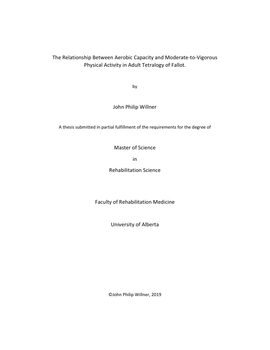This decommissioned ERA site remains active temporarily to support our final migration steps to https://ualberta.scholaris.ca, ERA's new home. All new collections and items, including Spring 2025 theses, are at that site. For assistance, please contact erahelp@ualberta.ca.
- 224 views
- 371 downloads
The Relationship Between Aerobic Capacity and Moderate-to-Vigorous Physical Activity in Adult Tetralogy of Fallot
-
- Author / Creator
- Willner, John P.
-
Background. Tetralogy of Fallot (ToF) patients have an aerobic capacity of ~ 50% of age-matched controls. This diminished aerobic capacity may partially be attributed to pulmonary regurgitation that limits augmentation of cardiac output during exercise. ToF patients have also been reported to be less physically active than their healthy peers, further diminishing their aerobic capacity. The extent to which low daily physical activity (PA) levels may contribute to the reduced peak oxygen uptake (VO2peak) observed in ToF patients is not clear.
Purpose. To evaluate the relationship between aerobic capacity (VO2peak) and daily time spent in moderate-to-vigorous PA (MVPA ≥ 3.0 METs) in patients with ToF (or ToF-like physiology), and to compare these findings with healthy age and gender matched controls.
Methods. Thirty-eight participants were included in the analyses. The ToF patients (n=19, 12 M:7 F; age 27 + 7 years) were medically stable, with moderate or greater pulmonary regurgitation. The healthy controls (n=19) consisted of 12 males: 7 females and were of comparable age (28 + 7 years) to the ToF participants. VO2peak and submaximal cardiopulmonary exercise measures (e.g., ventilatory anaerobic threshold) were assessed using indirect calorimetry during a symptom-limited graded exercise test (SL-GXT). PA was assessed using multi-sensor accelerometer (SenseWear Mini Armband-SWA). PA participants were instructed to wear the SWA for a minimum of 4 consecutive days. Minute-by-minute data were then categorized into light PA (> 1.5 to < 3.0 METs) or MVPA ( 3.0 METs) and time spent in both categories were averaged over the recording period. Unpaired t-tests were used to compare the cardiopulmonary exercise measures and MVPA between the groups. Pearson correlations were used to determine the relationships between VO2peak and submaximal cardiopulmonary measures with MVPA within both groups.
Results. VAT (p = 0.156), and VE/VCO2 slope (p = 0.187) were comparable between the groups. The ToF group showed a lower VO2peak (p = 0.019) and oxygen uptake efficiency slope (OUES) (p = 0.018) compared with healthy controls. Healthy controls spent more time in MVPA (2.2 ± 1.2 hrs/day vs. 1.4 ± 0.8 hrs/day, p = 0.015). No correlation was found between daily time spent in MVPA and VO2peak (r = 0.094, p = 0.720) in ToF patients, whereas a moderate positive correlation (r = 0.685, p = 0.001) was found in healthy controls. There were no relationships between MVPA and submaximal measures in ToF patients (VAT: r = 0.352, p = 0.166; OUES: r = 0.144, p = 0.582; VE/VCO2 slope: r = - 0.200, p = 0.441). Conversely, strong correlations between MVPA and VAT (r = 0.912, p = 0.000) and OUES (r = 0.702, p = 0.001) were found in our healthy controls.
Conclusion. The ToF patients had a lower absolute aerobic capacity (L/min) compared to sedentary healthy controls. The ToF patients also spent less total daily time in MVPA. Present findings suggest that our ToF patients were achieving the daily recommended amount of PA, however further research is needed on the benefits of exceeding the recommended MVPA (≥ 30 min/day) on their aerobic capacity. The PA goal for ToF patients should be to decrease total sedentary time, while increasing PA and exercise participation should be encouraged. -
- Subjects / Keywords
-
- Graduation date
- Fall 2019
-
- Type of Item
- Thesis
-
- Degree
- Master of Science
-
- License
- Permission is hereby granted to the University of Alberta Libraries to reproduce single copies of this thesis and to lend or sell such copies for private, scholarly or scientific research purposes only. Where the thesis is converted to, or otherwise made available in digital form, the University of Alberta will advise potential users of the thesis of these terms. The author reserves all other publication and other rights in association with the copyright in the thesis and, except as herein before provided, neither the thesis nor any substantial portion thereof may be printed or otherwise reproduced in any material form whatsoever without the author's prior written permission.
